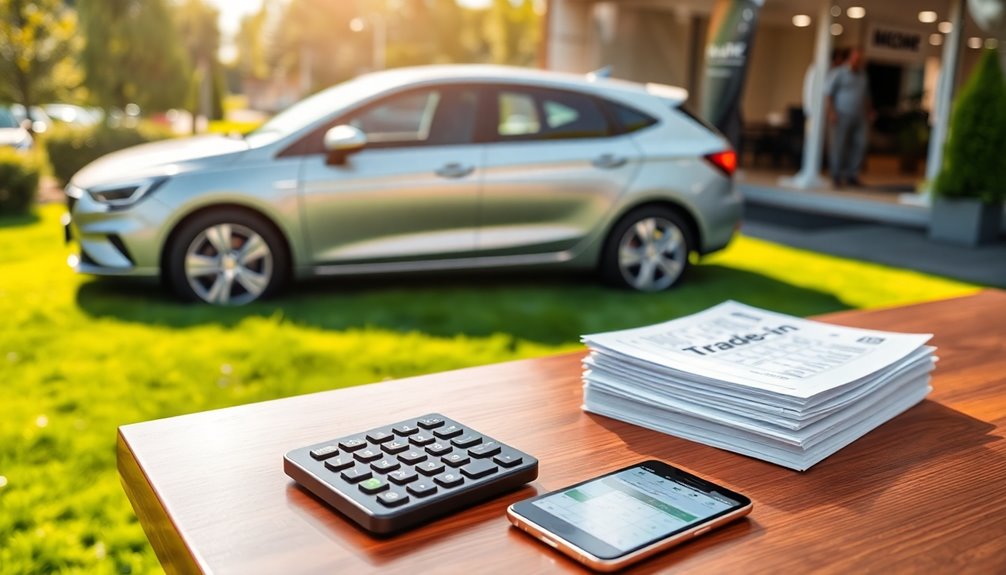To get out of your car lease, start by reviewing your lease agreement for early termination clauses. Assess any fees that apply and explore buyout options, checking if you can sell the vehicle for a profit. Consider transferring your lease to another person to avoid fees, using platforms like SwapALease. Don't forget to evaluate trade-in opportunities at a dealership and thoroughly analyze the financial implications. Communicate with your lessor about your plans and document every interaction. If needed, seek legal advice to navigate any tricky terms. Knowing these steps prepares you well for your next move.
Key Takeaways
- Review your lease agreement for early termination clauses and associated fees to understand your financial obligations.
- Calculate total costs, including early termination fees and the vehicle's residual value, to assess affordability.
- Explore lease transfer options to have someone else take over payments without incurring additional fees.
- Consider a lease buyout if the current market value exceeds the residual value, allowing potential profit upon resale.
- Document all communications with your leasing company for clarity and to support your case during the termination process.
Review Your Lease Agreement
Before you do anything else, grab your lease agreement and take a close look at it. This document holds the key to understanding your options for getting out of your car lease.
Focus on any clauses related to early termination fees, as they can greatly affect your finances. Make sure you understand the termination fee structure, which often includes a flat fee and calculations based on the vehicle's residual value.
Next, check for any mileage limits outlined in the agreement. If you've exceeded these limits, be ready for additional charges when you return the vehicle.
Don't overlook the options for lease transfer or lease buyout within the agreement. A lease transfer might allow someone else to take over your payments, while a lease buyout could let you purchase the car for a predetermined amount.
Assess Early Termination Fees

Before you make any decisions about ending your lease early, you need to understand the terms outlined in your lease agreement.
Calculate the total termination costs, including any early termination fees and the vehicle's residual value, to get a clear picture of what you're facing.
This knowledge will help you avoid unexpected expenses and plan your finances more effectively.
Understand Lease Agreement Terms
Understanding your lease agreement is essential, especially when it comes to evaluating early termination fees. These fees are typically outlined in your lease contract and can include a flat fee along with the difference between your remaining lease payments and the vehicle's current value.
The residual value, which estimates the car's worth at the end of the lease, greatly impacts the total cost if you decide to terminate early.
It's important to familiarize yourself with the specific terms of your lease agreement, as penalties for early termination can sometimes exceed the total of your remaining monthly payments.
Costs can vary based on factors like the vehicle's age, mileage, and condition, so reviewing these elements is necessary for accurate financial planning.
Calculate Total Termination Costs
To calculate your total termination costs, start by closely examining your lease agreement for any specific early termination fees. These typically consist of a flat fee plus the difference between the lease balance and the vehicle's current value. Remember, the total cost of early termination can exceed the sum of your remaining monthly payments, especially if the vehicle has depreciated considerably.
Next, factor in the vehicle's residual value, which is influenced by its age, mileage, and condition at the time of termination. Here's a quick breakdown to help you assess potential costs:
| Cost Component | Description | Estimated Amount |
|---|---|---|
| Early Termination Fee | Flat fee as per lease agreement | $X |
| Lease Balance | Remaining payments owed | $Y |
| Current Vehicle Value | Current market value of the car | $Z |
| Possible Additional Fees | Charges for excessive wear and tear or mileage | $W |
Understanding these specific terms regarding early termination is essential for effective financial planning and avoiding unexpected expenses.
Explore Lease Buyout Options

Exploring lease buyout options can be a smart move if you're looking to take ownership of your vehicle before the lease ends. A lease buyout typically requires you to pay the residual value, which is predetermined at the start of your lease and reflects the vehicle's expected worth at lease end.
To avoid surprises, you'll want to verify the total payoff amount, including any remaining lease payments and fees.
Before committing to a buyout, assess the current market value of your vehicle. If the market value exceeds the residual value, buying the car can be financially advantageous. After purchasing, you might even consider selling the vehicle, which could help recoup some of your buyout costs.
Evaluating current market conditions and vehicle demand is essential in deciding whether a buyout aligns with your financial future. If you believe the vehicle will maintain or increase its value, a lease buyout might be the right path for you.
Consider Lease Transfer Possibilities

When you're looking to get out of your car lease, considering a lease transfer can be a smart move.
This process involves finding someone willing to take over your payments, which can save you from hefty termination fees.
However, it's essential to understand your responsibilities and the steps involved to guarantee a smooth changeover.
Lease Transfer Process Overview
A lease transfer can be an effective way to exit your car lease without the financial penalties associated with early termination. This process involves finding a qualified new lessee to assume your lease payments and responsibilities, typically requiring approval from your leasing company. Many people use online platforms to connect with individuals looking to take over leases, making it a cost-effective solution.
Before proceeding, review your lease terms carefully. Some agreements may state that you, as the original lessee, retain liability as a co-signer even after the transfer is complete.
Most leasing companies allow transfers without significant fees, provided the new lessee meets the credit and financial requirements established in your original lease agreement. Understanding credit score impacts can help ensure you make informed decisions throughout the process.
Successfully transferring your lease can help avoid negative impacts on your credit score, as it doesn't involve defaulting or facing early termination fees.
Finding a Suitable Assignee
Finding a suitable assignee for your car lease is vital to guaranteeing a smooth handover process. Before you start, review your lease contract to confirm whether your leasing company allows lease assumptions and any associated payments and fees. This step is significant to avoid unexpected costs later.
Next, utilize online platforms like SwapALease.com and LeaseTrader.com to find someone interested in taking over your lease. These websites connect you with potential assignees easily, making your search more efficient.
However, don't forget that the prospective assignee must meet the leasing company's credit requirements, so they might need to undergo a credit check before the handover is approved.
Also, keep in mind that you may remain financially responsible as a co-signer after the lease handover. It's important to clarify your liabilities with the leasing company to protect yourself from future complications.
Document all communications and agreements related to the lease handover to guarantee a smooth shift. Following these steps will help you find a suitable assignee and complete your lease handover successfully.
Responsibilities After Transfer
After successfully finding a suitable assignee and completing the lease transfer, it's important to understand your ongoing responsibilities.
First, check with the leasing company to confirm that the lease transfer is approved and to clarify any fees involved. Remember, the new lessee must meet the leasing company's credit requirements, which often includes a credit check before final approval.
Even after the transfer, you might still be held responsible as a co-signer if the new lessee defaults on payments, depending on the leasing company's policies. This means you should keep an eye on their payment history to avoid any surprises.
To prevent liability issues, verify that all necessary documentation is completed correctly and submitted promptly. Additionally, it's important to understand that bad credit leasing options may affect potential assignees' ability to qualify for the lease transfer.
If everything goes smoothly and all conditions are met, the lease transfer shouldn't impact your credit report.
However, it's wise to verify with the leasing company to confirm you're fully released from obligations. Staying proactive will help you avoid potential pitfalls and guarantee a smooth changeover for both you and the new lessee.
Evaluate Trade-In Opportunities

Evaluating trade-in opportunities can be a smart move when you're looking to exit a car lease. Start by reviewing your vehicle's current market value against the remaining lease balance. This will help you determine if trading it in could yield positive equity that you can apply to a new lease or purchase. Many dealerships offer trade-in incentives, and some may even waive early termination fees when you lease or buy a new vehicle from them.
Next, consider the condition, mileage, and service history of your leased vehicle. These factors will greatly impact its trade-in value and the dealership's willingness to negotiate.
Don't settle for the first offer; instead, research multiple dealerships to compare trade-in offers and find the best deal, as values can vary widely.
Keep in mind that while trading in a leased vehicle can alleviate some financial burdens, you may still owe any remaining payments if the trade-in value doesn't cover the lease balance.
Research Online Lease Swapping

If you're looking to exit your car lease without hefty fees, researching online lease swapping can be a smart option. Online services like SwapALease.com and LeaseTrader.com make it easier for you to find people willing to take over your lease. This often costs less than paying early termination fees, making it an attractive alternative.
Here are some steps to evaluate when using lease swapping platforms:
- Check Your Lease Agreement: Make sure there are no restrictions on lease transfers before moving forward.
- List Your Lease: Most platforms allow you to list your lease for free or a nominal fee, reaching a wider audience.
- Provide Accurate Information: Be transparent about your lease terms and vehicle condition to attract serious assumers.
- Utilize Available Resources: Many websites offer guidance on the transfer process, ensuring you comply with your leasing company's requirements.
Successfully transferring your lease can help you avoid negative impacts on your credit score associated with early termination.
Analyze Financial Implications

When you're thinking about getting out of your car lease, it's essential to understand the termination fees that could hit your wallet.
Evaluate your buyout options carefully, as the total costs can sometimes outweigh what you'd expect.
Knowing these financial implications will help you make a smarter decision.
Understand Termination Fees
Understanding termination fees is crucial for anyone contemplating getting out of a car lease early. These fees can greatly impact your finances, so it's important to grasp what they entail.
Typically, early termination fees consist of a flat fee and the difference between your remaining lease balance and the vehicle's residual value. This can vary based on the car's age, mileage, and condition at termination.
Here are four key points to keep in mind regarding termination fees:
- Flat Fees: Review your lease agreement for specific flat fee amounts tied to early termination.
- Residual Value: Understand how depreciation affects your vehicle's residual value, as this will influence your total costs.
- Additional Penalties: Be aware that returning the vehicle early may lead to extra penalties that increase your financial implications.
- Alternative Options: Explore other cost-effective routes like lease transfer or buyout to avoid hefty termination fees.
Evaluate Buyout Options
Exploring buyout options can greatly influence your decision to exit a car lease. Start by calculating the buyout price, which involves the vehicle's residual value—the estimated worth at lease end. You'll need to add any remaining lease payments and fees to arrive at the total cost.
Next, compare this buyout amount against the current market value of the vehicle. If the market value is higher than your buyout, selling the car can yield a profit.
Make sure to review your lease agreement for specific buyout terms. Some contracts may impose penalties or additional fees that could affect your overall financial outcome. The depreciation rate of the vehicle also plays a role; cars that maintain their value better may offer you a more favorable buyout scenario.
If you're considering financing the buyout, assess the interest rates and monthly payment terms carefully. These factors will considerably impact the long-term financial implications of taking ownership.
Seek Legal Advice if Needed

Steering through the complexities of your car lease can sometimes feel overwhelming, especially if you suspect unfair terms or face challenges with early termination. In these situations, seeking legal advice can provide clarity and protect your rights. Legal professionals who specialize in automotive and leasing contracts can help you navigate the intricate details of your lease.
Here are four key reasons to contemplate legal advice:
- Understanding Your Rights: A legal expert can explain your consumer rights, especially if your lease contains unfair terms.
- Addressing Financial Hardships: If you're facing financial hardships, a lawyer can suggest potential remedies or defenses related to your lease obligations.
- Negotiation Support: Legal advice can assist in negotiations with the leasing company, potentially reducing fees or restructuring your lease terms to your advantage.
- Awareness of State Laws: Some states have laws that protect consumers from predatory leasing practices, and a legal professional can inform you of these protections.
Taking these steps can empower you to tackle your car lease termination with confidence and knowledge. Don't hesitate to reach out for help when needed.
Communicate With Your Lessor

Once you've assessed your situation and sought legal advice if necessary, the next step is to communicate with your lessor. Initiate this conversation as soon as you recognize the need for lease termination. Be ready to discuss your financial situation and any changes that justify your request.
Here's a quick reference table to help guide your discussion:
| Topic | Details |
|---|---|
| Early Termination Fees | Ask about specific fees associated with ending your lease early. |
| Lease Transfer Options | Inquire if you can transfer your lease to someone else and what's required. |
| Lease Agreement Clarity | Request clarity on terms, including residual values and credit score implications. |
Communicating clearly and effectively with your lessor is essential. Understanding your lease terms can help you navigate the process smoothly. Don't hesitate to ask questions to guarantee you know all your options. Whether it's about early termination fees or the possibility to transfer your lease, gathering this information puts you in a stronger position to manage your financial situation.
Document All Interactions

Documenting all interactions with your leasing company is important for a smooth lease termination process.
Keeping a detailed log helps guarantee clarity and accountability, which can be critical if disputes arise.
Here are four key steps to help you document effectively:
- Log Communications: Record dates, times, names of representatives, and summaries of conversations. This creates a thorough record of your interactions.
- Save Written Correspondence: Keep all emails and letters from the leasing company. These documents may be essential for clarifying agreements or resolving disputes later.
- Follow Up: If you reach any agreements during phone calls, send a follow-up email summarizing what was discussed. This gives you written confirmation of what was agreed upon.
- Retain Important Documents: Keep copies of relevant lease documents and payment records. These can provide context and support your claims if discrepancies arise during the lease termination process.
Frequently Asked Questions
How Do I Break Out of a Car Lease?
To break out of a car lease, you've got a few options.
You could return the vehicle, but watch out for hefty termination fees.
If you're looking for a cheaper route, consider transferring the lease to someone else, if allowed.
Another choice is buying out the lease, which lets you own the car but requires settling any remaining payments upfront.
Always check your lease agreement for specific terms and penalties before making a decision.
How Do I Walk Away From a Leased Car?
To walk away from your leased car, you can return it to the dealer, but you'll likely face early termination fees.
Check your lease agreement for specific penalties, as they can vary.
You might consider transferring the lease to someone else, which could save you money.
Another option is a lease buyout, allowing you to own the car outright.
If you're struggling financially, look into provisions that might waive fees.
Is It Difficult to Get Out of a Car Lease?
It can be difficult to get out of a car lease, mainly due to potential early termination fees and specific penalties outlined in your contract.
You'll need to carefully review the terms before making a decision. Options like transferring the lease or requesting voluntary repossession might be available, but they come with their own challenges and consequences.
Weighing the financial implications of each choice is vital to finding a suitable solution.
What if I Can No Longer Afford My Leased Car?
If you find yourself in a tight spot with your leased car, don't worry; you've got options.
You might consider returning the vehicle, but be ready for some fees.
Transferring your lease to someone else can be a smooth way to lighten your financial load.
Alternatively, think about a lease buyout; if the car's worth more than what you owe, you could make a profit.
Explore these choices to ease your situation.
Conclusion
Getting out of your car lease doesn't have to be overwhelming. By understanding your options and communicating effectively with your lessor, you can make the process smoother. Did you know that nearly 30% of leased vehicles are returned early? You're not alone in this decision! Whether you choose a buyout, transfer, or trade-in, stay informed and proactive. With these steps, you'll be on your way to a more suitable vehicle in no time!










